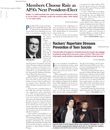Maybe your children would be happier sitting through a couple of days of CME lectures, but in case they get restless, there's plenty of other things children can do while mom or dad bones up on the latest in SSRIs and the DSM-IV.
Speaking of bones, a good place to start with most children might be the Fernbank Museum of Natural History, where skeletons of a 47-foot-long Giganotosaurus and a 123-foot-long Argentinosaurus do mock battle in the atrium.
Unearthed in the badlands of Argentine's Patagonia region, these two (who would have been diner and dinner back in the Mesozoic) should impress even the most jaded dinosaur fans. But dinosaurs are not the only attraction at the Fernbank.
The museum's main permanent exhibition, “A Walk Through Time in Georgia,” tells the story of the state's natural history and, by extension, the development of the planet. A series of realistic dioramas captures the sights and sounds of the state's geography, covering roughly 1.5 billion years.
The journey begins in the piedmont, the geologically oldest region, and ends at the coast and barrier islands, Georgia's youngest region. Visitors see an array of animals and plants and the world these creatures call home.
Humans had something to do with Georgia's natural history, too. An overview of Georgia's prehistoric human inhabitants explores cultures throughout the entire range of Native-American occupation (11,500 B.C. to A.D. 1838), focusing on the chiefdoms of the late prehistoric period (A.D. 900 to A.D.1540). Artifacts drawn from each of the major cultural periods in Georgia's human past accompany a time-line describing the political structure, subsistence, and settlement patterns of Georgia's indigenous societies.
The permanent exhibition “Sensing Nature” demonstrates how vision, sound, smell, touch, and taste help us perceive the natural world.
Of course, the classic children's experience is visiting the zoo, and Zoo Atlanta presents about 200 species, both familiar and endangered. Gorillas, orangutans, tigers, lions, giraffes, elephants, birds, and more range in reconstructed natural habitats. The giant pandas of Chengdu recently opened their doors to visitors, while the Sumatran Tiger Forest exhibits endangered Sumatran tigers and, as of 2004, a clouded leopard. The habitat simulates Indonesian forest glades, with waterfalls, rivers, and rocky crevices for the tigers to explore. Sekayu and Jalal, the tigers, are part of a breeding program being carried out at Zoo Atlanta as part of the Species Survival Plan of the American Zoo and Aquarium Association.
When the kids are ready to fold, don't fight it. Just take them to the Robert C. Williams American Museum of Paper-making at the Institute of Paper Science and Technology, where folding is an art and a science. The museum features a collection of 10,000 papers, tools, and paper-making machines. A new papermaking studio and greenhouse show how paper fiber is grown and how paper is made. Guided tours should be booked in advance.
The museum will also present “Unfolding: An Installation” by Mona Waterhouse through May 26.
Any place that allows kids to write on the walls is sure to be a big hit with the under-8 crowd.
While children's museums elsewhere target children of all ages, Imagine It! The Children's Museum of Atlanta is aimed at younger children.
“It's a place where little kids can run wild,” said museum spokesperson Danica Kombol. “Just remember, all grown-ups must be accompanied by a kid, and all kids must be accompanied by a grown-up.”
The museum's prime attraction in May will be “Critters,” a celebration of all things creepy, crawly, furry, and feathery, to help kids recognize their living friends in the animal kingdom. The entire museum will be transformed into a “critter palace,” said Kombol.
Other parts of the museum offer children the chance to learn or create.“ Let Your Creativity Flow” invites children to express themselves through movement, manipulation, and sound. Here, kids can actually paint on the walls, not to mention the chance to make music, create sand sculptures, and become a member of a dance troupe.
“Tools for Solutions” helps children engage in creative problem-solving fun. A giant ball machine requires visitors to use their ingenuity, as hydropower, kinetic energy, cranks, planes, and gears move balls into a giant basket.
Children also travel underground to glimpse life under their garden, learn how to care for plants, and build their own patio.
“Leaping Into Learning” lets toddlers and preschoolers crawl through a friendly forest, put on a puppet show in the hidden tree house, splash in a stream, and get a fish's view of the world.
Among the daily programs, visitors may meet a master gardener, a local chef, a director from a local theater, and listen to a story teller.
Puppet shows, puppet-making workshops, and interactive exhibits keep kids and parents entertained for hours at the Center for Puppetry Arts. In May, the center will present Jon Ludwig's “Brer Rabbit and Friends,” based on the stories of Atlantan Joel Chandler Harris. Create-a-puppet workshops introduce children aged 5 and up to the art and craft of puppetry and let them take home their creations.
The Atlanta Botanical Garden, adjacent to Piedmont Park on Piedmont Avenue, reveals the beauty and science of the plant kingdom. In the Everyday Garden, visitors can learn how plants transform solar energy into starches and sugars in photosynthesis and so provide vegetables and grains for food, lumber for houses, and plants for medicine, fragrance, and clothing. The“ Everyday Plants” garden demonstrates how plants are routinely used in daily life.
“Grandma's Garden,” set in the 1850s, includes plants that European, African, and Asian settlers and other immigrants brought to America for food, medicine, and garden ornaments. ▪
